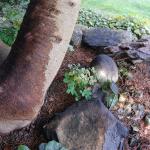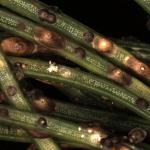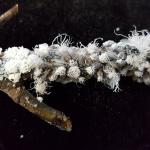Scouting for Piercing-Sucking Pests of Trees and Shrubs
Certain types of insects feed on their host plants with piercing-sucking mouthparts. Typically, this involves the removal of plant fluids as these insects feed while attached to plant leaves, needles, twigs, branches, and sometimes trunks. Many of these insect species belong to the order Hemiptera, also known as the “true bugs”. This can include but is not limited to certain species of aphids, mealybugs, soft scales, armored scales, and lace bugs. Some non-insect arthropods, such as spider mites, may also cause problems as they feed on fluids from plant leaves and needles.
What are some clues we can use to monitor for the presence of these pest insects in our landscapes in the absence of the pests themselves? The following indicators may help:
Signs of Piercing-Sucking Pests
- Eggs – While it may not always be possible to ID an insect based on the presence of an egg or discarded eggshell alone, their presence can be helpful in alerting us to the need to continue to scout. While some insects with chewing mouthparts may eat the discarded eggshell from which they emerge thus leaving behind no clues to their presence, pests with piercing-sucking mouthparts are not able to do this. Therefore, the presence or past presence of certain pests, such as aphids and even spider mites may be detected via left behind eggshells.
 Honeydew – This sugary secretion is a waste product produced by piercing-sucking insect pests such as aphids, soft scales, mealybugs, and certain hoppers. Leaves may look shiny from a distance if they are coated with this substance. Honeydew can coat leaves and branches, and both may eventually appear dark in color as sooty mold may grow on surfaces where honeydew is persistently available.
Honeydew – This sugary secretion is a waste product produced by piercing-sucking insect pests such as aphids, soft scales, mealybugs, and certain hoppers. Leaves may look shiny from a distance if they are coated with this substance. Honeydew can coat leaves and branches, and both may eventually appear dark in color as sooty mold may grow on surfaces where honeydew is persistently available.
 Scale covers (tests) – Armored scale insects are covered and protected by hard, waxy shields sometimes referred to as tests. With armored scales, this covering is not attached to the body of the insect itself, and can be removed to reveal the soft-bodied insect below. Soft scale insects may also be in whole or in part covered by a softer “test” that is physically attached to their body. Attempts to remove a soft scale cover will result in removing the entire organism from the location they are fixed to. In either case, these scale coverings can be left behind even after these insects have died, but they may still be useful for identification. (However, not always. Some closely related scale insects must be observed beneath a microscope for ID to be successful.)
Scale covers (tests) – Armored scale insects are covered and protected by hard, waxy shields sometimes referred to as tests. With armored scales, this covering is not attached to the body of the insect itself, and can be removed to reveal the soft-bodied insect below. Soft scale insects may also be in whole or in part covered by a softer “test” that is physically attached to their body. Attempts to remove a soft scale cover will result in removing the entire organism from the location they are fixed to. In either case, these scale coverings can be left behind even after these insects have died, but they may still be useful for identification. (However, not always. Some closely related scale insects must be observed beneath a microscope for ID to be successful.)
- Shed/Cast skins (exuviae) – As insects grow and develop, they shed or molt their exoskeleton multiple times during the course of their life cycle. The cast off exoskeleton (exuviae) is left behind by piercing-sucking insect pests and can be a useful sign of their presence.
 Tar spots – Sticky, black, sometimes shiny spots of excrement may be found on leaf surfaces where certain piercing-sucking insect pests are feeding. These “tar spots” are a quick and easy way to detect the presence of certain lace bugs found feeding on the underside of plant foliage such as that of rhododendrons and azaleas.
Tar spots – Sticky, black, sometimes shiny spots of excrement may be found on leaf surfaces where certain piercing-sucking insect pests are feeding. These “tar spots” are a quick and easy way to detect the presence of certain lace bugs found feeding on the underside of plant foliage such as that of rhododendrons and azaleas.
 Waxy/woolly material – These materials can be created by certain piercing-sucking insects as they secrete them over their bodies for protection. (Sometimes over eggs depending upon the species.) Waxy or woolly material may appear white or light in color and can be seen stuck to leaves, twigs, branches, or trunks. These materials can indicate the presence of certain woolly aphids, mealybugs, and some scale insects. Silk, mentioned below as a common sign of defoliating insects, may also be a clue indicating high populations of spider mites.
Waxy/woolly material – These materials can be created by certain piercing-sucking insects as they secrete them over their bodies for protection. (Sometimes over eggs depending upon the species.) Waxy or woolly material may appear white or light in color and can be seen stuck to leaves, twigs, branches, or trunks. These materials can indicate the presence of certain woolly aphids, mealybugs, and some scale insects. Silk, mentioned below as a common sign of defoliating insects, may also be a clue indicating high populations of spider mites.
Injuries to the host plant due to piercing-sucking pest insects may appear in various ways, including but not limited to: bronzing/yellowing of needles or leaves, gall formation on various plant tissues (ex. leaves, twigs, etc.), leaf distortion (ex. wrinkling, cupping, curling, etc.), scarring, and stippling.
This may not be an all-inclusive list for the types of clues that can be used to monitor for piercing-sucking insect pests. It is also important to remember that if these signs and clues are found on a tree or shrub of value that needs to be maintained, additional steps need to be taken prior to considering management. Identifying the host plant is often the first step to take to help identify the insect in question. Once an accurate insect identification is made, this may help when planning management options. Is this an insect that is known to be particularly damaging to its hosts? Is this plant susceptible, or has pest resistance been observed? Are there cultural or mechanical management options available for this pest, and if so, is this the correct time of year to conduct them? What natural enemies are known for the pest of concern? Are these natural enemies typically able to keep the pest population below damaging levels?
If the pest is not known to be particularly deleterious to the host plant involved, additional monitoring may be necessary through the season. Additional management options may not be necessary unless the plant has a history of damage due to the pest in question, or if damaging populations of the pest are observed or expected in the current season.
Need help identifying an insect pest on a tree or shrub? Submit a sample to the UMass Plant Diagnostics Laboratory here: https://ag.umass.edu/services/plant-diagnostics-laboratory/tree-shrub-diagnostics .
Sources:
Cranshaw, Whitney, and David J. Shetlar. Garden Insects of North America:
The Ultimate Guide to Backyard Bugs. Second Edition, Princeton University Press, 2018.